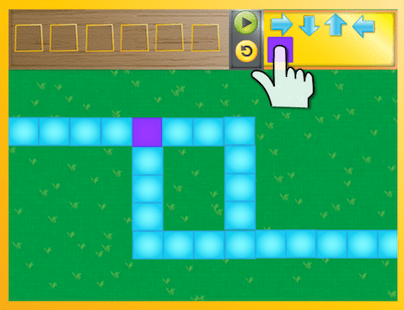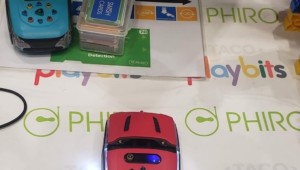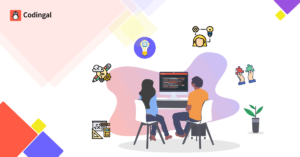Kodable: The First Step in Coding

A few weeks ago, I blogged for the need to teach young students coding. The small nation of Estonia starts teaching its children the concepts of coding in first grade. Estonia’s goal is not to turn everyone into programmers. Their goal is to have students better understand technology as it increasingly augments their lives. They do rank ahead of us in reading, math, and science (and no doubt coding), so it’s worth a look to see what they’re doing and to see how we can improve what we’re doing.
By sixth grade, Estonian students have a sound background in coding. The first graders, though, don’t start with actual coding or programming. They start with the logic behind the code. They master things like “sequence of events” and conditional statements like “If this is true, that will happen.” Those are great skills outside of coding, too.
I had a lot of questions about Estonia’s curriculum for its first graders after that blog. A great app to start with is Kodable. This app is for anyone who is new to coding, but it really targets 5 to 8 year olds.
Check out this introductory video:
Kodable offers this curriculum for ages 5 and up:
- Logic and problem solving skills
- Critical thinking skills
- Sequence of events
- Conditional Statements – “If this is true, that will happen”
- Loops – repeating a set of commands
Those are essential skills to have at any age or in any class. Coding and programming are not just for the tech wizards. Programming can take the user deep into content knowledge, too.
From the Kodable developers:
Why code with Kodable? Even before your children can pronounce the word “algorithm” they have an astounding ability to learn how to use them. Today’s best programmers fell in love with coding at a young age by experimenting with the concepts taught in Kodable. Understanding the basics of programming empowers your child for the jobs of tomorrow, and expands your child’s mind to solve problems today in more intelligent ways.
Grechen Huebner from the Kodable team gave Getting Smart a detailed overview of their app.
Website
What’s your elevator speech?
Kodable is an iPad game that teaches kids the basics of programming. We created Kodable because some parents we know kept telling us that they wanted to teach their kids to code because they knew how important it would be for their future. We are very passionate about getting kids interested in computer science and Kodable is a great way to do that.
Kodable teaches kids computational thinking, logic and key programming concepts like conditional statements, loops, functions, and debugging. Kids drag and drop commands to program their fuzz to roll through the exciting Technomazes on the planet Smeeborg just like you would program a computer to run a program. Unlike other programming education tools, Kodable is completely text free to ensure it is inviting and fun while also educational.
What are Kodable’s best features?
Kodable is designed to be inviting to girls.
Children can play Kodable before they can read because we don’t include any text and are entirely based on symbols.
Kodable is an introduction to logic and computational thinking
We’re launching a Parent/Teacher Portal next week that will give parents and teacher much more control over the app and tutorials on improving their experience.
How does your product impact classroom, school, district, community?
Kodable makes programming education inviting for students at a young age. This is important for diversifying the computer science area, because it gets students interested and thinking about computer science before society has an opportunity to tell them that programming isn’t cool or for girls.
We’ve also talked to a lot of teachers who want to use iPads but are unsure about how to include it in lessons. We decided to make Kodable easy to integrate by creating a curriculum with lesson plans, tutorials, and explanations of key concepts.
What kind of results have you seen?
When we were testing the game during development, we asked kids what the symbols meant. They were able to tell us exactly how a computer would read the program. For example, ” if the square is purple, then go down.”
What grade levels is Kodable most suitable for?
K through 2nd grade.
What subject areas are covered?
Programming education
What are the technology requirements?
Kodable is only available on the iPad.
What’s your support structure?
Our users can contact us via email through the app or our website at [email protected]. Contacting us through twitter (@Kodable) is often the fastest way to get a response, although we pride ourselves on always having a quick response.
What’s your pricing structure?
We have Kodable available for free with two in app purchases for 1.99 each. Each in-app purchase offers a new “lesson” in programming. The second world – Function Junction – teaches about functions. This is a key concept to programming which essentially stores commands in memory so that you can use them later. The third world – Bugs Below – actually teaches kids to “debug” their code, and actually squish a few bugs in the process :). We give them a set of commands with an error in it, and they must find the error and correct it to squish the bug and complete the level.
We also offer Kodable Pro for 2.99 which has all the same content for an up front cost.
We did this because schools that use Kodable can’t do in-app purchases, and some parents are averse to them.
Thanks for that, Grechen!
Kodable is a great place to start with our youngest students. Once they have mastered those early programming and coding concepts, have the level up to Hopscoth, where they can expand those skills.







0 Comments
Leave a Comment
Your email address will not be published. All fields are required.